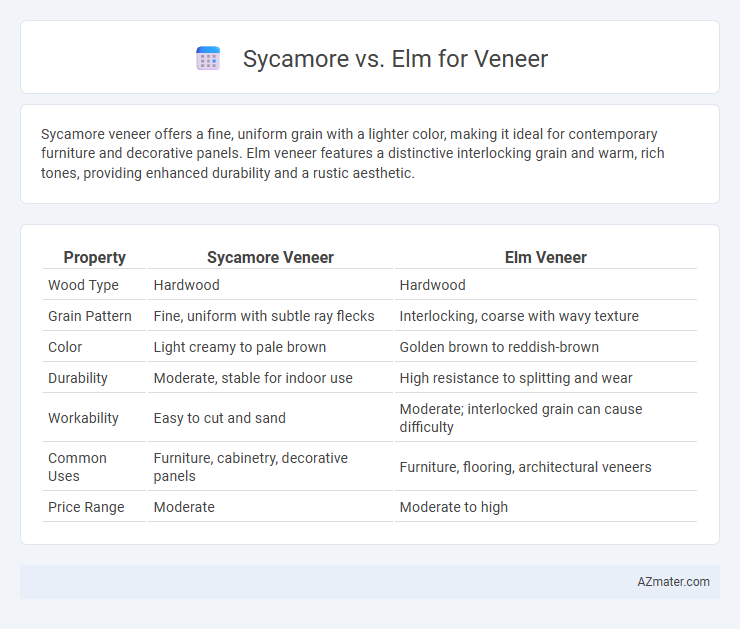Sycamore veneer offers a fine, uniform grain with a lighter color, making it ideal for contemporary furniture and decorative panels. Elm veneer features a distinctive interlocking grain and warm, rich tones, providing enhanced durability and a rustic aesthetic.
Table of Comparison
| Property | Sycamore Veneer | Elm Veneer |
|---|---|---|
| Wood Type | Hardwood | Hardwood |
| Grain Pattern | Fine, uniform with subtle ray flecks | Interlocking, coarse with wavy texture |
| Color | Light creamy to pale brown | Golden brown to reddish-brown |
| Durability | Moderate, stable for indoor use | High resistance to splitting and wear |
| Workability | Easy to cut and sand | Moderate; interlocked grain can cause difficulty |
| Common Uses | Furniture, cabinetry, decorative panels | Furniture, flooring, architectural veneers |
| Price Range | Moderate | Moderate to high |
Overview: Sycamore and Elm as Veneer Choices
Sycamore and Elm veneers offer distinct aesthetic and structural qualities for woodworking, with Sycamore known for its fine, even grain and light cream to reddish-brown hues, making it ideal for smooth, polished surfaces. Elm veneer features a prominent interlocking grain pattern with rich, warm tones ranging from golden to deep brown, providing a rustic and textured appearance suitable for traditional or vintage designs. Both woods are durable and versatile, but Sycamore's consistent grain contrasts with Elm's pronounced texture, influencing their selection based on desired visual effects and project requirements.
Botanical Background: Sycamore vs Elm
Sycamore (Platanus occidentalis) and Elm (Ulmus spp.) both belong to distinct botanical families, with Sycamore classified in the Platanaceae family and Elm in Ulmaceae, influencing their wood grain and texture differences. Sycamore veneer exhibits a fine, even grain with subtle flecking due to its diffuse-porous hardwood structure, while Elm veneer is characterized by an interlocked grain pattern and coarse texture resulting from its ring-porous hardwood anatomy. These botanical distinctions impact the durability, workability, and aesthetic appeal of each veneer type in woodworking and furniture applications.
Grain Patterns and Aesthetic Appeal
Sycamore veneer features a distinctive, wavy grain pattern with a creamy, light tone that enhances its natural warmth and visual depth, making it popular for elegant furniture and cabinetry. Elm veneer showcases an interlocking grain with variegated streaks and a slightly darker, reddish-brown hue, lending a rustic and textured appeal ideal for traditional or craftsman styles. Both woods offer unique aesthetic qualities, with Sycamore prized for its subtle sophistication and Elm valued for its rich, dynamic character in veneer applications.
Color and Visual Characteristics
Sycamore veneer features a light creamy color with subtle reddish hues and a fine, uniform grain that enhances its smooth, consistent appearance, making it ideal for contemporary and minimalist designs. Elm veneer exhibits a rich, warm brown color with prominent, wavy grain patterns and occasional knots, offering a more rustic and character-filled visual appeal. Both woods provide unique aesthetic qualities, with sycamore's brightness suited for modern interiors and elm's natural texture preferred for traditional or rustic styles.
Workability for Veneer Production
Sycamore veneer is highly valued for its excellent workability due to its fine, even texture and consistent grain, making it easy to slice thinly without splintering. Elm veneer, while offering attractive interlocking grain patterns, can be more challenging to work with because of its coarse texture and tendency to interlock, which may cause difficulties in achieving clean, thin cuts. Both species provide distinct aesthetic qualities, but Sycamore's smoother surface and predictable grain structure generally result in higher efficiency and less waste during veneer production.
Durability and Resistance to Wear
Sycamore veneer offers moderate durability with good resistance to wear, making it suitable for decorative applications where appearance matters more than heavy use. Elm veneer is known for its superior durability and natural resistance to wear, favored in furniture and flooring that require long-lasting performance. The interlocking grain pattern of elm enhances its strength and resistance to scratches compared to the finer, more uniform grain of sycamore.
Common Applications in Furniture and Interiors
Sycamore veneer is prized in furniture and interiors for its light, creamy color and fine, even grain, making it ideal for modern and Scandinavian-style pieces such as tabletops, cabinets, and wall panels. Elm veneer, recognized for its interlocking grain and rich, warm hues, is commonly used in traditional and rustic furniture, including chair backs, drawer fronts, and decorative interior accents. Both veneers provide durability and aesthetic appeal, with Sycamore favored for sleek, contemporary designs and Elm chosen for textured, classic environments.
Cost Comparison: Sycamore vs Elm Veneer
Sycamore veneer generally costs less than elm veneer due to its more abundant availability and faster growth rates. Elm veneer, prized for its unique grain patterns and durability, tends to be priced higher, reflecting its limited supply and slower maturation. When budgeting for veneer materials, choosing sycamore offers a cost-effective option without compromising on aesthetic appeal in many woodworking projects.
Environmental Impact and Sustainability
Sycamore veneer is favored for its rapid growth rate, which contributes to sustainable forestry practices and reduces environmental strain compared to slower-growing elm trees. Elm veneer, while prized for its durability and unique grain pattern, often requires harvesting from older, less abundant trees, impacting biodiversity and increasing carbon footprint. Sycamore's ability to regenerate quickly and its lower demand for pesticides make it a more eco-friendly choice in veneer production.
Choosing the Right Veneer: Sycamore or Elm?
Sycamore veneer offers a smooth, light-toned surface with subtle grain patterns ideal for modern, minimalist designs, while Elm veneer provides a rich, medium-brown color with distinctive, interlocking grain suited for traditional or rustic aesthetics. Durability and workability are comparable, but Sycamore's fine texture lends itself better to intricate detailing, whereas Elm's characterful grain adds warmth and visual interest. Selection depends on design goals, with Sycamore favored for sleek elegance and Elm chosen for natural, textured appeal.

Infographic: Sycamore vs Elm for Veneer
 azmater.com
azmater.com